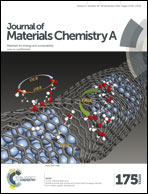Free-standing NiV2S4 nanosheet arrays on a 3D Ni framework via an anion exchange reaction as a novel electrode for asymmetric supercapacitor applications†
Abstract
NiV2S4 nanosheet arrays are grown on Ni foam by an anion exchange reaction using Ni3(VO4)2 nanosheet arrays as a template. The height and thickness of Ni3(VO4)2 nanosheet arrays are ∼200 and ∼10 nm, respectively, and the thickness increases with increasing reaction time. The shape and size of NiV2S4 nanosheet arrays remain unchanged after the anion exchange reaction of Ni3(VO4)2 nanosheet arrays. The NiV2S4 nanosheet array exhibits better electrochemical performance than the Ni3(VO4)2 nanosheet arrays. The NiV2S4 nanosheet array based electrode exhibited a specific capacity of 639 C g−1 at 2 mA cm−2 with enhanced rate capability and an excellent capacity retention of 90.7% at 30 mA cm−2 current density after 2000 cycles. The better electrochemical performance of the sulfide based electrode as compared to the oxide one is related to low electronegativity and large size of sulfur, which creates a robust structure and better transport properties. An asymmetric supercapacitor is fabricated, using NiV2S4 nanosheet arrays as the cathode and activated carbon (AC) as the anode, which shows high specific capacity (206 C g−1), energy density (45.1 W h kg−1) and power density (240 W kg−1) at 0.3 A g−1. 90.7% specific capacity retention after 1000 consecutive charge–discharge cycles makes it a promising candidate for future high energy storage systems.


 Please wait while we load your content...
Please wait while we load your content...